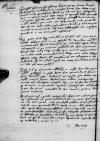Litteras tuas ex itinere ⌊Brugis⌋, ⌊Antwerpiae⌋, ⌊Vradislaviae⌋ et novissime binas ⌊Cracoviae⌋ datas accepi; fuerunt mihi gratissimae. Fecisti me tibi tua hac diligentia, qua in rebus meis erga ⌊regiam⌋ et ⌊reginalem maiestatem⌋ usus est, non parum devinctum. Tantum abest, quod quicquam superinscribed in place of crossed-out id⌈idamam superinscribed in place of crossed-out id⌉ horum retinere in animo deberem, quae inter nos vehementius acta sunt. Tu tibi de me certo, velim, persuadeas, ubi tibi et tuis umquam commodo et ornamento atque usui esse possum, me impigre, quoad eius a me fieri potest, affuturum.
Quod petis, ut te ⌊reginali maiestati⌋ et communi ⌊domino nostro Cracoviensi⌋ commendare debeam, fiet a me sedulo; tu vicissim nostris dominis conterraneis reverendissimis ⌊Varmiensi⌋ et ⌊Culmensi{s}⌋ episcopis, ⌊Margenburgensi{s}⌋ et ⌊Pomeraniae palatinis⌋ et domino capitaneo Sluchoviensi reliquisque omnibus, quo<s> amicos cognoveris, me in dies redde commendatiorem illisque more nostro obsequia offeras idque dicas, quod verissimum est, me nihil optare a Deo ardentius, quam ut aliquando post tot meas exanclatas aerumnas cum illis esse una possim.
Post tuam ex ⌊Granata⌋ abitionem, in mense Decembri gravissime podagra in pede dextro sum excruciatus et demum huc veniens coepi laborare ex capite, quo dolore represso manum hanc dextram, quae adhuc malagmatis vincta est, chiragra invasit; haec me tam saeviter torsit, quod de manu amputanda cogitarim, satis quam diu nihil scribere potui. Haec sunt mercedes, ut hic vocant, quas in ⌊Hispania⌋ referimus.
Reliquum est, quod tibi iniungendum duxi, ut ad me scribas crebrius, et quam condicionem sis in curia habiturus, et ubi tibi opera mea prodesse posse written over u⌈uee written over u⌉m. Non frustrabor tuam de me opinionem. Bene vale et me domino doctori Iacobo apud ⌊dominum reverendissimum Cracoviensem⌋ atque omnibus amicis et contubernalibus nostris commenda. Hospitae praeterea meae cum filiabus in Vandeta salutem ex me dicito, et quomodo habent, et quid ibi rerum fit, aliquando abunde describe.

 BCz, 242, p. 186
BCz, 242, p. 186